I started a series last year to try to describe to readers what it’s actually like in selected cities worldwide. Too often travel writers highlight points of touristic interest or glamorize a destination only to elevate it beyond its reality. That is their job: to sell destinations.
I wanted to go beyond that and tell you what it’s like in Luang Prabang and how it might be to linger a week or two there. I started this series with: What it’s like in Bangkok.
Table of Contents
I’ll start by saying Luang Prabang is a pleasant place to spend a few days.
The historic capital of Laos sits serenely on a peninsula where the Nam Khan River flows into the Mekong. You’ll sometimes see a couple of men fishing in the river and local boys and foreign travelers swimming or lying in the late afternoon sun on a sandy island. Out on the busier Mekong, long “slow” boats will be docked with others out on the river. The old town is mostly situated on the peninsula. The streets here are quiet and mostly void of traffic save the odd motorbike or two. Tourists will be seen walking around or peddling bicycles. Besides guesthouses, homes, and a few cafes, this is predominantly the domain of temples and old monasteries that function to this day.
Out in the Streets
Novice monks dressed in saffron robes glide along the sidewalks. Their satchels are slung across their shoulders and hold umbrellas overhead, providing protection from the overhead sun. It is warm here, sometimes hot. Palm trees poke out from the other vegetation that lines the street. Colonial architecture is no more than two stories high. The facade colors are elegantly fading. As you leave the historic center, you’ll see fewer tourists, almost none when you reach a point after about 15 minutes walking. There isn’t much traffic, except the main roads can get heavy with motorbikes and scooters at morning and afternoon rush hour. But aside from this, the air is mostly clean and free of excessive noise.
During high season the amount of foreign visitors is shocking. You’ll wonder how such a small town could accommodate such numbers. But Luang Prabang copes. The off-season, from April to October will see fewer visitors and lower prices.
Food
It’s tough to find Lao food—which is surprising as well as disappointing, because it’s quite nice and a little different than in neighboring Thailand or Vietnam. An obvious place to look is at the night market. Lao food is there discreetly—mok sin wrapped up in a banana leaf or other specialties spooned into plastic bags for takeaway. But more plentiful at the night market is a variety of generic Asian stir-fried dishes. Overall the night market is neither interesting nor exciting like ones I’ve visited in Luang Namtha or Vientiane.
The more expensive restaurants also offer some Laotian dishes in addition to Western ones, but are much more costly. On the edges of the historic district you can find less expensive cafes serving up stir-fry, and rice and noodles for backpackers at reasonable prices.
Street cart vendors make chicken, egg, bacon, veggie and other sandwiches on French bread starting at 10,000 kip ($1.25). Noodle soup runs about 10,000 kip and fried rice 15,000. A big bottle (640ml) of the ever-popular Beer Lao usually costs 10,000 kip. Bars are numerous around town.
Costs
Like much of Southeast Asia, Laos is considered an inexpensive destination for travelers. Although more expensive than the rest of Laos, Luang Prabang is still comparable to many places in Thailand. Be aware that prices can almost double in the high season. Also note that prices throughout the country for basic traveler necessities (accommodation and food) have been rising sharply in recent years.
Very basic double rooms in Luang Prabang start at around 40,000 kip ($5 US). You may be able to get a dorm room for 30,000kip ($3.75). But the city has a vast array of accommodation and you could spend much more if you prefer an atmospheric locale or higher quality amenities. Most of the accommodation is set on quiet streets amid lush vegetation or overlooking either of the rivers.
Peculiarities
Tourists and locals rarely mix in Luang Prabang—which is quite odd considering how friendly and curious Laotians can be. Locals don’t eat out often and you rarely see tourists at a local café, or vice versa. Luang Prabang, like most of Laos, is a disturbingly segregated place. Local cafés, with menus on the wall written in Lao only, rarely feel welcoming to foreigners. Tourist eating establishments in the old town will see only the likes of foreigners.
In the historic district much of the local life has been squeezed out in favor of tour companies, tourist cafés, money changers, and souvenir shops. Try to walk the narrow lane back streets and you’ll find some local homes that have remained next to the temples despite the tourism encroachment.
Another mystery of Luang Prabang is its development as a center of geriatric tourism. It’s odd when you think of how remote and difficult this place is to get to. I assume they’re flying in as part of group tours. I don’t know any other destination I’ve seen such a high concentration of 65+ year old travelers.
One last bit you should know is the city-wide curfew. Most guesthouses will lock their doors or shut their gate at 11:30pm or midnight. There is no after-hours nightlife save for the Bowling Alley on the edge of town.
Sites
I like to say to myself that “there sure are a whole lot of tourists here for a city with no sites to see”. That is not entirely true. Luang Prabang is primarily one of those destinations that you visit for the atmosphere. The waning architecture, the pleasant cafes, the lively night market, and the many temples are reasons enough to visit Luang Prabang. In mornings and evenings you can listen to the monks chanting inside the temples.
First and foremost, this city is a religious center and you’ll be visiting plenty of Buddhist temples and monasteries. The older and bigger complexes charge 20,000 kip ($2.50 US) to enter, but there are others that are open, working monasteries. Visit any of those and a curious monk may see you and be interested in chatting to learn about you and practice his English.
One of the biggest draws in Luang Prabang happens every morning at dawn. Hundreds of monks from the various monasteries walk through the streets at 6am collecting alms. Villagers and townsfolk bring prepared food to offer the monks.
Besides the abovementioned, there isn’t too much to do here. Although somehow I’ve managed to linger for more than a week, I was attracted by the good internet connections, minimal distractions, and the quiet pace of life here that I experienced last June during low season. This time around it’s high season and was more hectic.
It’s also worth noting that Luang Prabang is located in a malarial zone.
Visit my Flickr page for more photos of Luang Prabang.
Have you been to Luang Prabang? When did you visit? How was your experience?

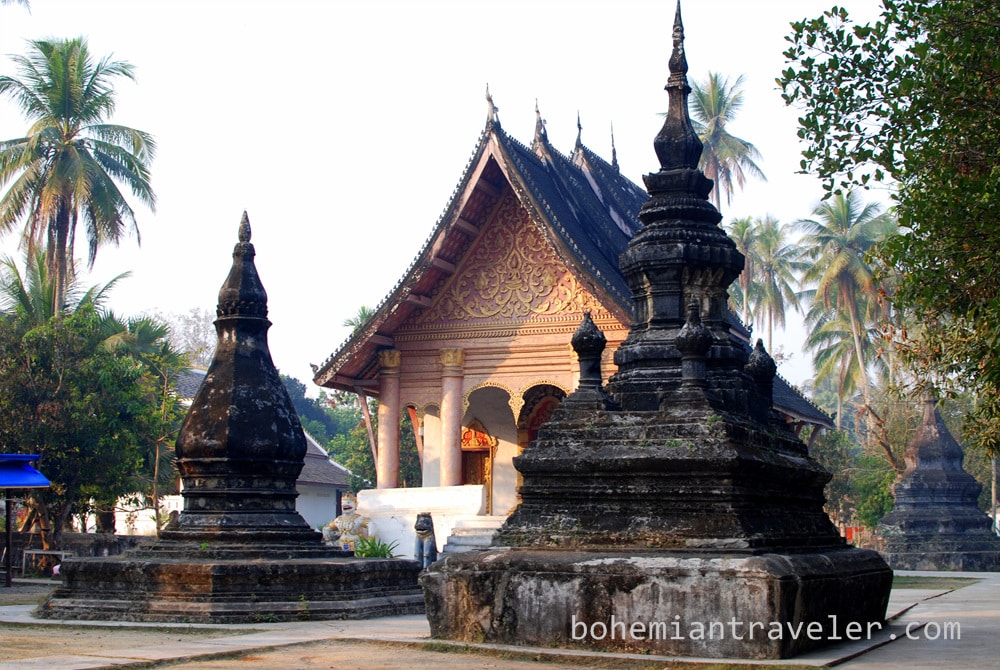

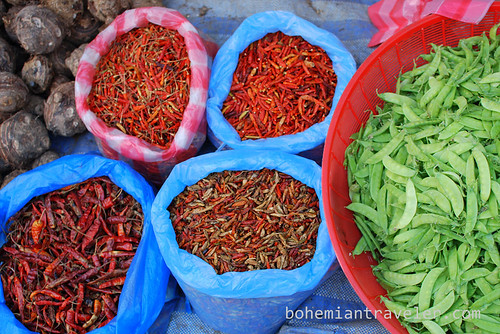

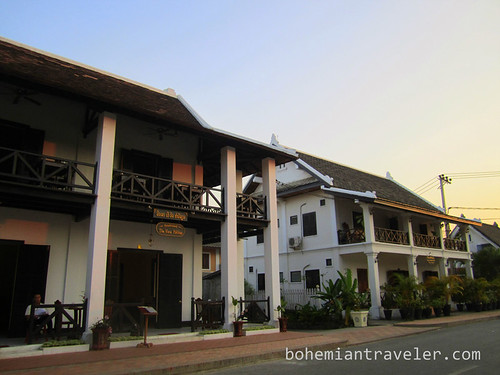

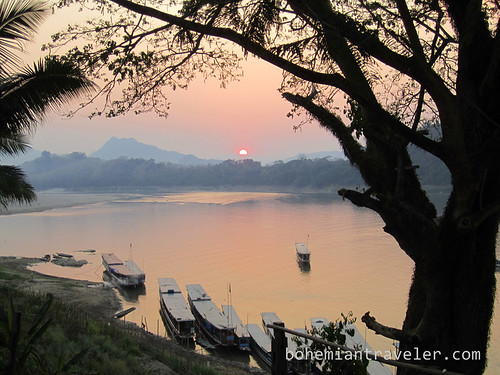

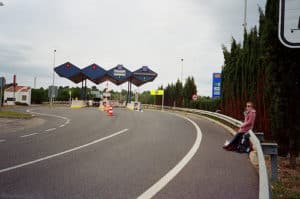

Pingback: A Digital Nomad in Luang Prabang | Bohemian Traveler
I’m probably heading to Luang Prabang in the next couple of months, so this post came at a good time and is very useful! Thanks!
One of my favorite destinations in all southeast Asia. Loved the low sweeping temple roofs. Also they have one of the most gorgeous waterfalls outside of town.
@Heath–Didn’t check out the waterfall outside town-even though every driver in towns offers to take you there. maybe next time.
Pingback: What it Costs: A Day of Travel in LaosGoMad Nomad Travel
This brought back so much memory! I really liked Luang Prabang, the only regret – not seeing the monks’ alms collection in the morning.
Pingback: Luang Prabang in Photos | Bohemian Traveler
Pingback: The Sights and Sounds of Luang Prabang – VideoGoMad Nomad Travel
Yes – twice, and loved it! Our highlights included admiring the temple architecture, perusing the night market, and riding an elephant at a refuge not far from the city. The elephant ride almost didn’t happen, though, as we acquired a bug the morning of – likely via the scrumptious fare at the night market.